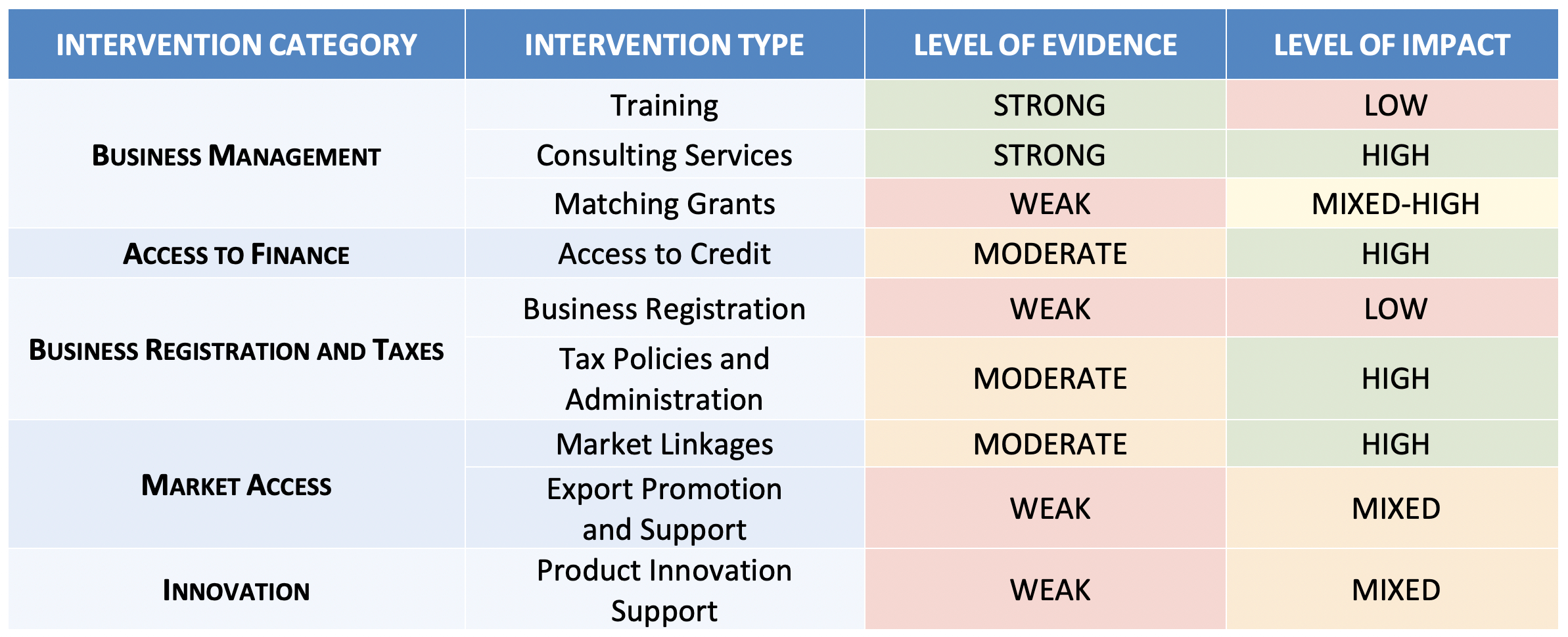Small and medium enterprises (SMEs) are critical drivers of growth in developed and developing economies alike. In the U.S., small business accounts for more than 40% of GDP. SMEs play an even larger role in frontier markets. The World Economic Forum estimates that SMEs in Africa comprise 80% of all employment and are a key driver in fueling the continent’s growing middle class. Given the importance of SMEs to economic development, it is essential that policymakers understand how to effectively catalyze small business growth.
Recognizing the importance of entrepreneurship and firm development in emerging and frontier markets, policymakers and development practitioners have designed and implemented programs focused on a range of SME development activities. Though these programs and policies are popular, they are not always grounded in what the latest research tells us and do not always sufficiently link entrepreneurship project interventions to indicators of SME growth.
In collaboration with USAID’s Office of Trade and Regulatory Reform (TRR), Resonance reviewed the latest research and interviewed SME development experts to create a taxonomy of the most common intervention theories. Our research—outlined in the full report Theories of Change: High-Growth Small and Medium Enterprise Development and summarized in the heatmap below—reveals that the levels of impact and evidence vary greatly among different types of interventions.

Recommendations for scaling sustainable enterprise development in frontier markets
Based on these findings, we have highlighted a number of recommendations for donors:
Compare, then prioritize high-impact interventions
When developing projects, program designers should compare different intervention types, and focus on interventions with moderate to strong evidence that support high impact results. For instance, while training is one of the most common methods for supporting SME owners and employees, there is strong evidence to suggest that tailored consulting services and coaching are more effective than classroom-style trainings. Other factors driving the growth of SMEs in frontier markets include tax policy reforms, access to credit, and comprehensive market linkages programs.
Design contextually relevant interventions
Start with an assessment to understand the actual constraints to SME growth in that context. It’s worth taking the time to ensure that we are appropriately laying out all of our assumptions, clearly identifying our target beneficiaries, and evaluating aspects of the theory of change that have not been previously well researched. It’s also important to consider the trade-offs between cost and impact of specific intervention methods, and only adopt the most cost-effective intervention for those that are proven to have an impact.
Cultivate an evidence-based mindset
In addition to providing a better understanding of the comparative impact of intervention types, a key recommendation included in the report is to do what we know works, based on the evidence. Often donors and implementers design projects based on experience and the perceived impact of previous projects rather than on the latest research and evidence. We should continue to learn from and adapt to new evidence. There are ample opportunities for more research.
“We tend to leverage research in the early stages of design,” said Anastasia de Santos, Economist at USAID Office of Trade and Regulatory Reform, in the recent MarketLinks webinar that presented these report findings. “After the project is awarded or we've written our work plans, they tend to sit on a shelf. Really, we should be going back and checking our theories of change against new evidence regularly and learning, adapting in real time.”
SME development is not a new field—it has been around for more than 30 years. That rich experience provides donors and policy-makers with a substantial evidence base on what works. By designing evidence-based SME development programs, we are better able to tap into the energy and dynamism of the world’s entrepreneurs to catalyze sustainable growth.
Photo courtesy of U.S. Agency of International Development.

